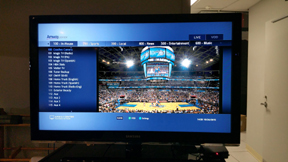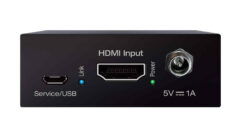
SVC Podcast – Show Notes – Show 144-2:
In this edition of the SVC Podcast, SVC Contributing Editor Bennett Liles finishes his conversation with John Curtis of CTG in Atlanta about the complete renovation and upgrade of the Orlando Magic’s digital signage system in Amway Center. John goes into detail on the installation and control aspect of the new Vitec IPTV system in Amway Center including IR extension, serial control, MAC addresses and EZ TV software control.
Links of interest:
- Amino set top boxes that are used at the monitor locations
- Four Winds interactive players included on some of the set top boxes
Download Podcast Here:
https://s3.amazonaws.com/nb-svc/public/public/144-2_Vitec_Orlando_Magic_…
From Sound & Video Contractor Magazine, this is the SVC Podcast with John Curtis of CTG. Show notes for the podcast are available on the web site of Sound & Video Contractor Magazine at svconline.com.
When a front-line sports franchise like the Orlando Magic decides to completely revamp their home arena with the latest digital signage and IPTV system, they can afford to have the best hardware and the best outfit to install it. They called CTG in Atlanta and what they got was a sight to behold, in fact, lots of sights. John Curtis is going to take us into the control aspect of it, coming up next on the SVC Podcast.
John, thanks for getting back with us on the SVC Podcast from CTG in Atlanta and the all new IPTV system for the Orlando Magic in Amway Center. When you came in there you knew this was going to be rolled out for thousands of Orlando Magic fans so what was the first thing that had to be done on getting this all in and working? You didn’t just take everything out and start over. I think you already had some things to work with.
Absolutely. The first thing was key to having a seamless transition and after we worked on the logistics plans with Dave Storm and his team down there, the first thing was really to get the Vitec encoding system on the head end installed and up and running. And of course, any sort of cut over like this, you don’t want to take the old system down until you know the new system is up and running. So really we brought the Vitec head-end coders online, made sure that those were running, and then right before a very large event in the facility, we set our downtime and made the switchover from one encoding system to the other. We verified that all of our streams were present and had strategic testing throughout the facility to make sure that all that was happening. And once everybody was comfortable with our go/no go decision, we had decided to move forward and put the Vitec online pretty seamlessly. [Timestamp: 2:00]
Okay. And you have to control all of these things and give the fans just the right amount of control at their end, so how did you manage to control all of the set-top boxes? Was that through IR links or serial connections, network lines, or who can do what from where?
We’ve got a couple of different options here. So the primary function is where we’re giving the users control is in the premium suites seating areas. So there are a number of suites that have the Amino set-top boxes that, again, function like your traditional set-top box at home. The Amino boxes are mounted behind the TV’s; either as high or as low as we could get them behind the TV without being visible to the end users. Then we went in with just the traditional provided IR remotes. We did some basic testing. In a couple of cases we needed to do some basic IR extension on those particular units, but for the most part the Aminos are pretty flexible in terms of their IR reception, so didn’t have to do much of that. In some other spaces, really more of the club areas where we’ve got more of an AV component going on, a lot of the Aminos just operate purely as a set-top box that are controlled via an IR extension on a Crestron system. I believe, if my counts are correct, there’s probably 18 of those areas throughout the facility. For CTG’s part, we had to go through and do a fair amount of upgrade to existing Crestron control code to make sure that we had control of the Amino set-top boxes correctly. But once we got that in place, it was pretty easy to copy and paste that information throughout the facility. The balance of the TV’s are TV’s that you’re going to find in concourses or monitors you’re going to find in concourses, and it’s probably a 2-to-1 mix between boxes that have the Four Winds interactive players on them and the Amino set-top boxes. In those cases, almost every monitor is hooked back to one of those two devices with a serial cable. That gives us capability to do power on/off commands. We can do input resets to monitors to make sure that we’re on the appropriate inputs, and we even have some limited spaces where we’ve got basic AV technology going on using some of those commands to the TV’s just to change inputs so if someone wants to go to a different input with their laptop in a presentation mode they can do that and that’s a pretty straightforward thing for us. But when the shipment came in it was a whole lot of set-top boxes and Four Winds players, and it was a whole lot of serial cable getting hooked up to make sure it all worked correctly. I will say that Vitec was very adamant about the Amway Center sending off a monitor or two. The testing that went into this ahead of the deployment was pretty extensive. I’m sure everybody can relate to the fact of the sheer number of monitors we were going to be dealing with, and we didn’t want to be in a situation at the end of the day where we swapped everything out and went to go test and it didn’t work. So we worked closely with the Amway Center and Vitec to ensure that they had actual monitors from the facility in their testing facility to test all the hooks and the commands and everything before we ever rolled with our actual deployment here. [Timestamp: 4:59]
And as you mentioned in Part 1, CTG and the Orlando Magic’s IT department had to cooperate very closely on this. One of the things is not throwing too much technology into the mix. It’s got to be easy to work, but it also has to give the fans enough features to leave home and get to the game for.
And you know, there was a lot of preplanning on the IT side. And a lot of the fans, they never get to see that side of technology; the amount of capturing IP addresses and MAC addresses and spreadsheets and reconciling spreadsheets and shipping labels and all that. Working with Vitec they really made it – the way their products deliver to us made it very easy. Don’t take for granted that you get a box with a piece of equipment in it that’s already got a serial number and a MAC address on the outside because that was really a pretty big key to all of this. We worked closely with Amway Center staff as they received their Four Winds players directly when we got the Amino players in on our side directly, and really coordinating and combining all of this information into a MAC address list that we could hand off to their IT department. That we said this particular MAC address is associated with this player at this specific location and making sure that all rolled back up in to the Easy TV manager software for the Vitec software. You don’t want to be turning TV’s on and off in zones that are the incorrect zone, so a tremendous amount of coordination on the front side of that, that folks just – they’ll never see, but for us the ease of use is always the thing that at the end of the day makes it worth it. [Timestamp: 6:32]
And then at some point along the way, handing off pieces of that to the local people and making the tweaks they want to make, then turning them loose on it and seeing what they can do.
And Dave Storm and his crew down there are top notch when it comes to the technical side. We worked very closely with the folks at Vitec and on CTG side. We set a lot of base templates for them. One of the nice things about that software from Vitec is you can set groups of monitors. So for the Amway Center, a call for a blackout in the facility at the start of a concert is usually very important, but you don’t want to blackout every monitor in the facility. You primarily want to black out monitors that are in direct viewing distance of the main seating bowl. So this is primarily suites and some concourse monitors and stuff that are visible. So we were able to work with them to set some of these baseline groups and showed them this is how you add monitors to or take away from, or if you need to make different subgroups on all of this. And really, the team down there picked it up very, very quickly and moved forward and really has taken ownership of it. And that’s always good to see with a client, that they can own something like this and make it their own at the end of the day. [Timestamp: 7:36]
And of course one of the most satisfying things has got to be just watching the fans come in and enjoy the new system and all of the oohs and ahs and pointing at the monitors. You’ve got to get a big charge out of it when you’ve gone through this much effort and you’ve got it all in and working.
It is, you know, very stunning to see in a facility of this size. CTG is fortunate to work with a tremendous number of venues throughout the United States, but I have to say that by far and away the Amway Center and their internal branding, they’ve got some of the best internal branding of any facility in the U.S. and really the Vitec system running in combination with the Four Winds players and the Amino set-top boxes allows them to do and deliver creative content in ways that we are just starting to scratch the surface of. It’s very exciting to walk in and see those sort of things in deployment. [Timestamp: 8:24]
Well, it was a huge job but you got that one done and I’m sure CTG already has other big jobs coming into focus now.
Bennett, there’s always a lot in the works for us. It never seems to slow down. We’re at the time of the year where all of the sports replay starts to dial back up and we are looking forward to working with more NBA teams in the future. We’re already talking to a few about potential to roll in some IPTV with their existing systems. We see this kind of deployment at the professional level quite a lot. I think we’re going to see another wave of this at the collegiate level. So we’re certainly looking forward to speaking with some of our friends and partners that we already have in the FCC network and the ACC network and those conferences as well as the folks that are out there in the Big 10 and Big 12 and see what’s available. It’s an interesting time we live in because we have all these systems. We’re very keen to realize that all of these become marketing tools and tools to really increase the fan engagement. So we’re always looking for ways to push the envelope and work with our partners to create that unique fan experience and market the different venues and their different products to their fans in ways that other folks can’t. [Timestamp: 9:32]
Always a challenge that stretches you but certainly the best advertisement for your work is the result, so just send them down there to an Orlando Magic game.
It’s been great. John Curtis from CTG in Atlanta and the new IPTV system from Vitec for the Orlando Magic at Amway Center.
Absolutely, Bennett. Look forward to having folks down in Orlando to check it out.
Thank you for being here with us for the SVC Podcast with John Curtis of CTG. Show notes are available on the website of Sound & Video Contractor Magazine at svconline.com. Be back with us again next week for the SVC Podcast.










